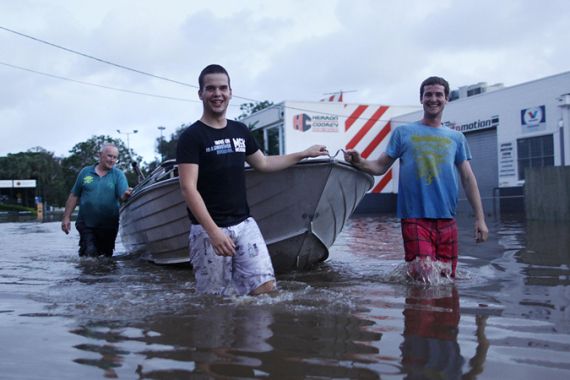Brisbane spared worst of floods
Floodwaters in Australia’s third-largest city peak at level much lower than feared, sparing city of more devastation.

 |
| The Brisbane river broke its banks and engulfed several areas of the city [Reuters] |
Floodwaters in Australia’s third-largest city have peaked at a level far lower than feared, according to police.
The wave of water that threatened to inundate large areas of Brisbane peaked on Thursday at more than a metre below the high that officials had feared would affect about 36,000 homes and businesses.
Keep reading
list of 4 itemsAfter the Hurricane
World’s coral reefs face global bleaching crisis
Why is Germany maintaining economic ties with China?
“The Brisbane River has now reached its peak,” a police statement said as an official weather bureau water gauge in the centre of the city of two million people recorded a flood depth of 4.45 metres.
The swollen river was expected to hover around that level for about one hour before slowly receding, Brett Harrison, a weather forecaster, told public broadcaster ABC.
“We still expect it to be above major flood levels until sometime during Friday and remain high over the weekend,” hen said.
Officials had predicted the river would exceed the last flood record of 5.45 metres that it hit during massive floods in 1974, but the forecast was repeatedly downgraded overnight.
“It is sunny here finally … and more importantly there isn’t any more rain, or significant rain, forecast throughout Queensland for the foreseeable future,” Al Jazeera’s Andrew Thomas, reporting from Brisbane, said.
“The water levels are already dropping … I think we are going to be seeing this ongoing peak for most of today and probably into tomorrow, but then quite quickly those waters should recede.”
Widespread damage
Widespread damage was still expected, however, as the swollen Brisbane river had already burst its banks in some areas and engulfed large areas of the city.
Campbell Newman, the Brisbane mayor, said that revised modelling based on a high flood peak of 4.6 metres showed that 11,900 properties would be fully flooded and 14,700 partially inundated.
“We all now have to rally together to help these people clean up, the ones that have suffered impacts,” he said.
The rapidly moving water also swept boats and pontoons from their moorings and toppled traffic lights on some streets.
Authorities were struggling to secure or break up three large objects or vessels on the Brisbane river, Anna Bligh, the Queensland state premier, said.
A rescue helicopter was due to fly in a 1.5 tonne anchor at first light to secure a ferry that had broken its guide lines and was seen as a potential hazard.
Garbage collections and bus services were cancelled, traffic lights were out of action and Brisbane’s port was open only for emergency supplies. Sewage from flooded homes spilled into the gathering torrents.
Arran Corbett from Sontek, a group which monitors river flows, told the AAP news agency earlier that the Brisbane river was flowing very rapidly at 9,400 cubic metres a second.
“To put it into perspective, that will fill about 1,000 Olympic pools in a second,” he said.
Thousands of people had already fled the city for higher ground before the river reached its peak after officials warned that the city was likely to see its worst flooding since 1974.
The waters have overwhelmed a dam built to protect the city after the 1974 deluge. Officials have opened the floodgates of the dam to prevent a greater disaster, contributing to the flooding.